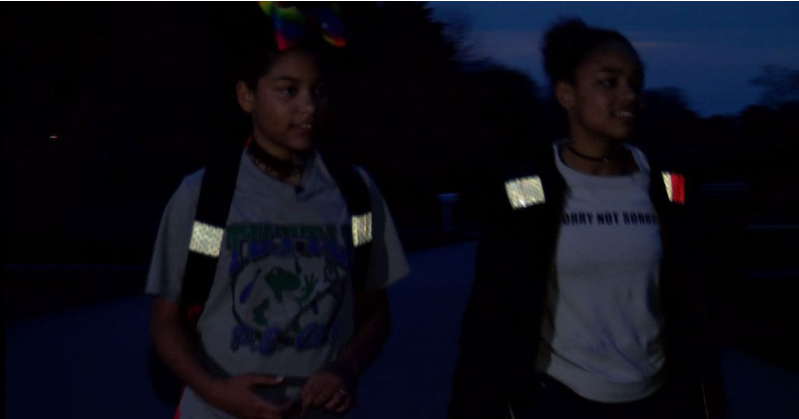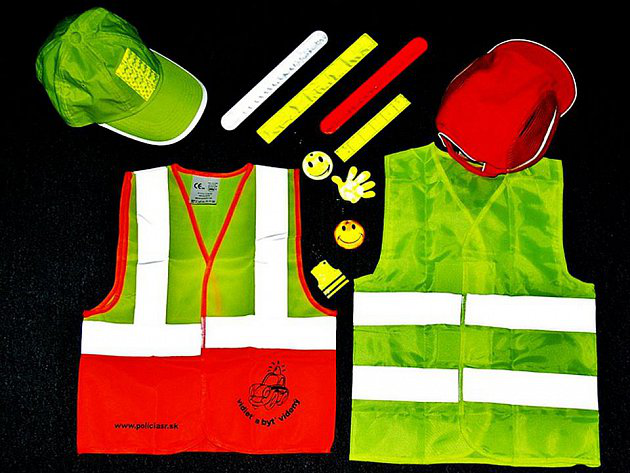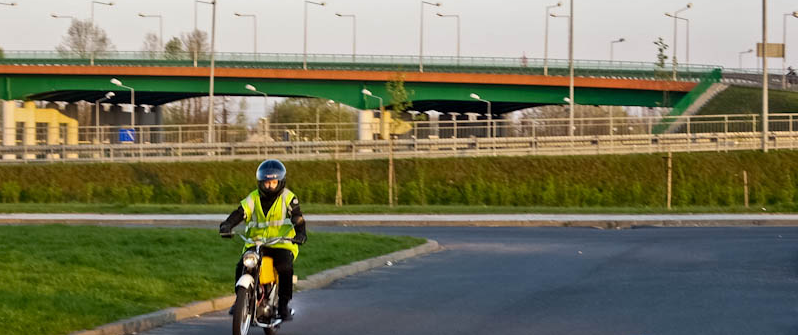The use of bicycle lighting, reflectors, and properly visible clothing is necessary for safe cycling both during the day and at night, because by determining our position on the road, we become noticeable to other road users. Cyclists “invisibility” increases the chance of being hit by, for example, a car, which is why every reasonable cyclist should be aware of the fact that being visible is the same as being safe on the road. It is also obvious that thanks to the lights when driving after dusk we will bypass dangerous obstacles. So what lighting to choose, where to put reflectors and is visible clothing only the one in bright colors?
At the beginning of the considerations regarding bicycle lighting, it is worth familiarizing yourself with the parameters that define them. Looking at the lamps of individual manufacturers, we will notice the information on the number of lumens (lm) or lux (lx) that characterize given light sources. These concepts often appear interchangeably as if they mean the same. Of course, this is not the case and due to the lack of knowledge in this aspect, you can be unpleasantly surprised. With the displacement of ordinary light bulbs and their replacement with modern LEDs, cotton wool was replaced with lumens. A lumen is a unit of measure for luminous flux, that is, it determines the light output of the lamp. Lux is, in turn, a unit of light intensity and determines what luminous flux falls on one square meter of surface.
- Daytime driving
Usually, when buying bicycle lighting, customers wonder how much the lamp they are interested in shines and how long the battery that powers it is working. These criteria are the most accurate, only that they usually refer to driving at dusk. However, before we start pedaling in the dark, it is worth considering how to ensure safety during daytime driving.
According to the regulations, the bicycle does not have to have lighting with normal visibility during the day, only reflectors that determine the position are sufficient. Nevertheless, lamp manufacturers offer us a wide selection of daytime running lights. Why this overprotection related to the need to spend another PLN? The offer of companies in this area is motivated by an analogy to the daytime running lights used in cars and motorbikes, and therefore the decrease in the number of accidents. Of course, every cyclist has the right to decide for themselves in this matter whether the above-mentioned statistics appeal to him, but solutions that manufacturers use, such as headlight amplification or uneven flickering and different intensity of the rear light are very interesting and probably helpful. If you decide to use bicycle lighting for daytime riding, you should choose, first of all, the brightest rear lamp flashing unevenly and a relatively brightly lit front lamp, which will also be equipped with a flashing mode. Front lighting with power over 100 lm is sufficient for driving during the day, while at the rear it is worth to arm yourself with a minimum of 20 lm. It is worth noting that the lamps are mounted in the right places and at the right angle, so that they shine in the right direction, towards approaching cars, and that they do not dazzle other road users.
Fluorescent clothing
Every cyclist should be at heart to be visible on the road during the day, by wearing appropriate clothing. During the day, fluorescent colors work best. This is because the sun’s rays ‘react’ with fluorescent materials and give them a glow effect. It should be remembered that clothing in so-called Fluo colors without sunlight just isn’t effective. I am aware that not all cyclists are lovers of clothing brightness. For lovers of two wheels, which are closer to subdued colors, it is recommended to use fluorescent accents on moving parts of the body (legs) or outfit colors other than black. It is worth using the contrast method in this respect because any color that makes us stand out a little bit on the road will make us be noticed.
- Night riding
While during the day, in conditions of normal visibility, the law does not require cyclists to install front and rear lights, after dark, as well as front and rear reflectors, are mandatory equipment of the bicycle. The lighting should be strong enough to make us visible to other road users from at least 150 meters.
The choice of a light source to pedal after dark should be adapted to the type of ride. So if you drive mainly around the city lit with lanterns, then you do not need lamps that have 500 lm of power. All you need is inexpensive LED lighting from leading manufacturers, whose power when it comes to the front lamp reaches approx. 150 lm, and at the back above 18 lm.
For people who are passionate about road riding, sunset does not necessarily mean the end of the fun. It is best to plan a journey on a route that you know very well, so as not to be surprised by a hole in the road. It is also worth buying two lights for both the front and rear of the bike. Then, not only that we ensure excellent visibility, but we will also protect ourselves in the event of a failure or battery depletion in one of the light sources. For road riding, you should choose front lights that emit focused light. Both in the city and outside it, above all, the rear light should flicker to attract drivers’ attention even more than the steady light. Also, it is good to buy lighting in shape and size other than a round, small spot. In the front, we can also afford a flashing mode, if it wasn’t a strobe mode, which just often irritates other traffic participants. Reflectors will also be a wise choice. Of course, I do not mean the obligatory ones: front and rear, but additionally on wheels, for example. Although they may not look professional, they also ensure the visibility of the cyclist from the side.
Lighting for driving after dusk in the field
Do you know by heart any protruding root on your favorite forest trail and think that it won’t surprise you anymore? Ride it after dark and you will experience amazing silence, sharpen your senses and start playing with it again. First, however, choose the right lighting. In this regard, it is worth equipping yourself with a light mounted on the steering wheel and the helmet light source will also be quite helpful. In terms of lighting on the steering wheel, it should be characterized by a minimum power of 300 lm (500 lm seems optimal), and it should also shine with diffused light. There are, of course, light sources with a much higher power, but in the case of a group night travel, this type of lamp can disturb the others who are not so equipped. It is worth noting that the strong lighting can change the mode, you can then reduce the light output to e.g. 15% of full power. When choosing the right light source for off-road driving, it’s a good idea to use a criterion for fixing it. The lighting installation should be reliable and must not loosen when driving over uneven surfaces.
The additional lamp on the helmet is designed to illuminate the road far ahead, from a different perspective than that installed on the steering wheel. It should shine in spots and not be too strong. It will also be useful in the event of a breakdown because you do not need to hold the flashlight during the fault.
Reflective clothing
Unlike fluorescent clothing, this reflective clothing works by reacting to artificial light. Therefore, the more directly the light, a reflector, acts on the reflector, the more it will reflect it. During night rides in the city or outside of it, reflective clothing is influenced by the light of lanterns or other traffic participants. In virtually all bicycle clothes you will find reflective piping, which is most often seen on the ends of sleeves or legs and a back pocket. If you are riding a bicycle in non-specialized clothing, it is worth buying reflective bands, which, for example, in addition to lighting in the dark can be used to narrow the leg so that it does not get caught in the crank. Many bicycle clothing manufacturers offer a series of reflexive items. For example, Endura produced the “Luminite” product line, which is characterized by fluo colors and large reflective tape elements. This series includes helmets, jackets, pants, backpacks, gloves and shoe covers.
- Power supply
When you rarely drive after dark and darkness during a ride you suddenly do not need to get more expensive lamps that have their chargers or batteries. For city driving, lighting with batteries or a generator is enough. dynamo. However, when night driving often happens, it is more profitable to spend more money on a good set of lighting and batteries, so we will not be forced to buy batteries all the time. However, if you decide on this type of power supply, remember to check the battery level so that we have enough electricity for the next trip. In the case of modern Ni-Mh batteries, it is not necessary to fully discharge them and charge them to 100%, as was the case with the older type of Ni-Cd batteries.
Whether in the city or outside, bicycle lighting is the responsibility of every cyclist. Undoubtedly, every cyclist should also be visible on the road by wearing fluorescent elements during the day and reflective elements after dark. Until the lovers of two wheels understand that being visible means being safe, there will be tragic accidents involving bicycles and motor vehicles. Every unlit cyclist – the so-called batman, must understand the frustration of drivers, and everyone properly lit should be noticed and properly avoided.



